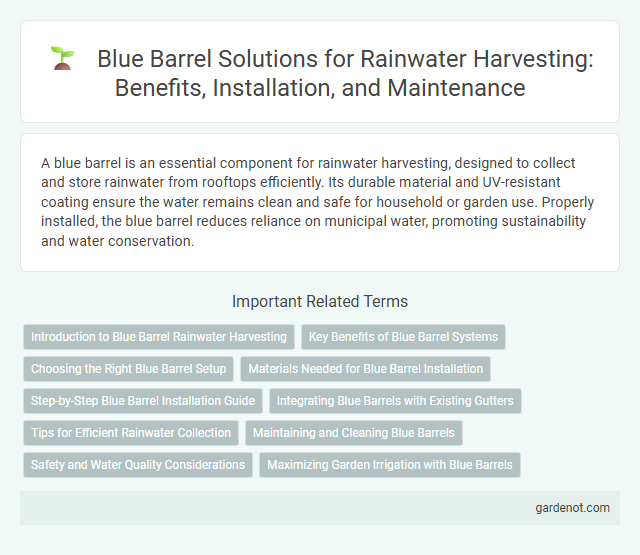A blue barrel is an essential component for rainwater harvesting, designed to collect and store rainwater from rooftops efficiently. Its durable material and UV-resistant coating ensure the water remains clean and safe for household or garden use. Properly installed, the blue barrel reduces reliance on municipal water, promoting sustainability and water conservation.
Introduction to Blue Barrel Rainwater Harvesting
The Blue Barrel rainwater harvesting system is an effective, low-cost solution designed for residential water collection and conservation. It uses a 55-gallon food-grade plastic barrel connected to rooftop gutters, capturing and storing rainwater for garden irrigation and non-potable uses. This method reduces water bills, minimizes stormwater runoff, and supports sustainable water management practices.
Key Benefits of Blue Barrel Systems
Blue barrel systems for rainwater harvesting offer efficient, cost-effective water storage solutions that reduce reliance on municipal supplies and lower utility bills. These systems improve water conservation by capturing and storing rainwater for irrigation, gardening, and other non-potable uses, promoting sustainable water management. Their simple design and ease of installation make them accessible for residential use, providing an eco-friendly alternative to traditional water sources.
Choosing the Right Blue Barrel Setup
Selecting the appropriate Blue Barrel setup for rainwater harvesting involves evaluating barrel size, material quality, and spigot placement to ensure efficient water collection and easy access. UV-resistant polyethylene barrels with a capacity between 50 and 60 gallons provide durability and sufficient storage for typical household needs. Proper placement under downspouts with secure fittings minimizes contamination while maximizing water capture efficiency.
Materials Needed for Blue Barrel Installation
Blue barrel rainwater harvesting systems require a sturdy plastic barrel, preferably food-grade polyethylene, to ensure safe water storage. Essential materials include a spigot for water access, a tap or hose connection, a mesh screen to filter debris, and sealant to prevent leaks around fittings. Proper installation also involves gutter downspout adapters and a secure platform or stand to elevate the barrel for gravity-fed water flow.
Step-by-Step Blue Barrel Installation Guide
Begin the blue barrel installation by selecting a stable, level surface near a downspout for optimal rainwater collection. Attach a downspout diverter or cut the downspout to channel water directly into the barrel's inlet, ensuring a secure fit to prevent leaks. Finish by installing a spigot near the base of the barrel for easy water access and adding a fine mesh screen on top to filter debris and prevent mosquito breeding.
Integrating Blue Barrels with Existing Gutters
Integrating blue barrels with existing gutters maximizes rainwater collection by channeling runoff directly into storage containers. Installing downspout diverters or flexible connectors ensures efficient water flow from roof gutters to blue barrels, reducing overflow and water loss. This system enhances sustainable water management for gardening and irrigation by capturing clean, roof-harvested rainwater.
Tips for Efficient Rainwater Collection
Blue barrels should be placed on a stable, elevated surface near a downspout to maximize rainwater capture. Installing a fine mesh screen over the barrel opening prevents debris and mosquitoes from contaminating the water. Regularly clean the barrel and check for leaks to maintain water quality and ensure efficient collection.
Maintaining and Cleaning Blue Barrels
Regular maintenance of blue barrels in rainwater harvesting systems involves inspecting for cracks, leaks, and debris accumulation to ensure water quality and system longevity. Cleaning blue barrels at least twice a year with a mild bleach solution or vinegar helps prevent algae growth and eliminates bacterial contamination. Properly sealed lids and clean gutters further reduce the risk of mosquito breeding and contamination in the harvested rainwater.
Safety and Water Quality Considerations
Blue barrels used in rainwater harvesting must be food-grade and BPA-free to ensure safe water storage without chemical contamination. Proper sealing and regular cleaning prevent mosquito breeding and algae growth, maintaining water quality for non-potable uses. Installing a first-flush diverter further reduces contamination by diverting initial runoff containing debris and pollutants away from the barrel.
Maximizing Garden Irrigation with Blue Barrels
Blue barrels effectively maximize garden irrigation by collecting and storing rainwater from rooftops, providing a sustainable water source during dry periods. Their capacity, typically 55 gallons, enables gardeners to reduce dependency on municipal water, promoting eco-friendly practices. Integrating multiple blue barrels with a drip irrigation system ensures consistent moisture levels, enhancing plant health and growth.
Blue barrel Infographic

 gardenot.com
gardenot.com